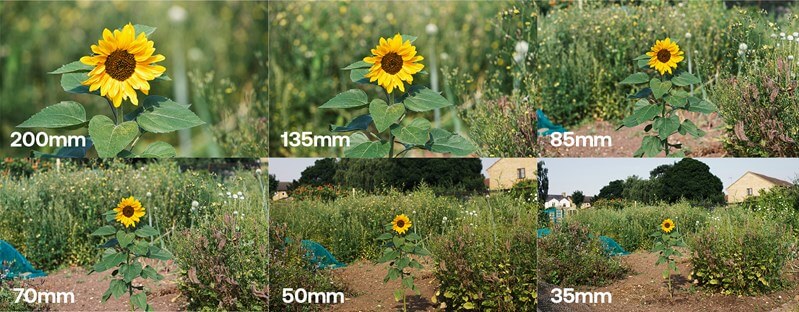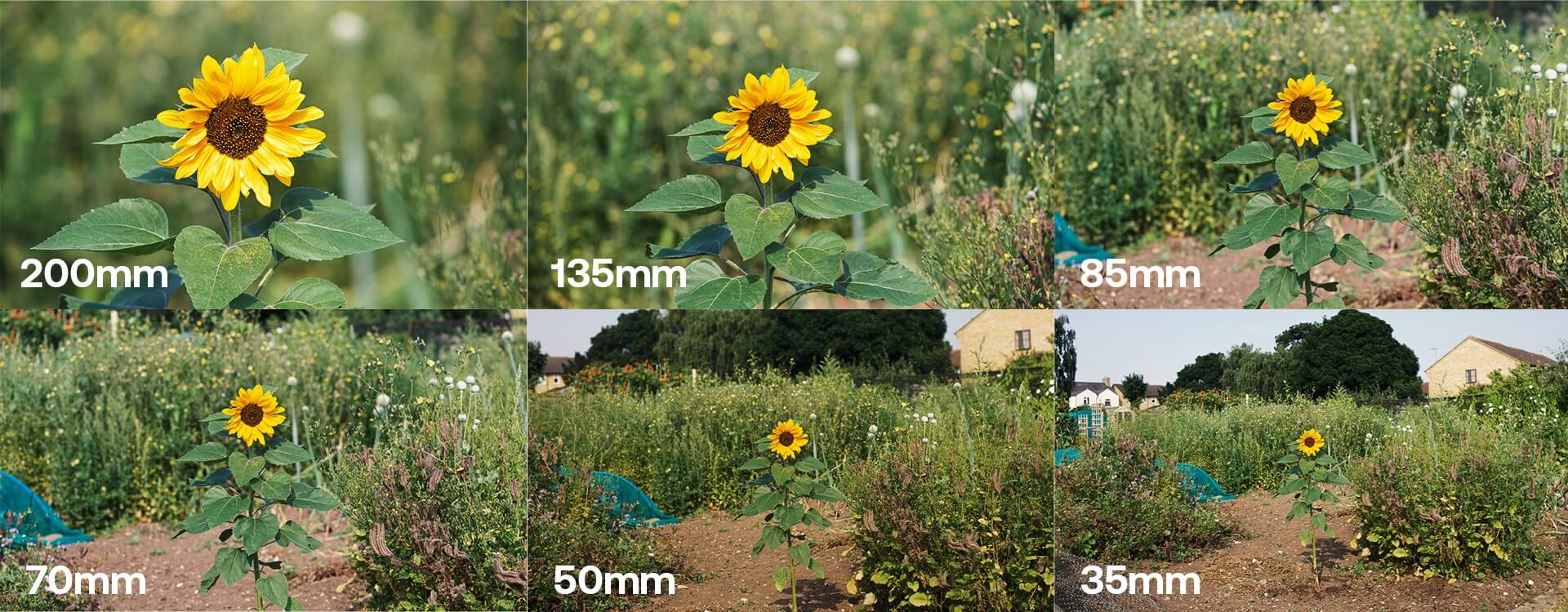Highlights
Table of Contents
Explore article topics
Choosing a focal length for every scene that you shoot is a huge creative decision. It determines how much of the scene will make it into the shot, how close the audience will feel to the subjects and what sort of background blur you’ll be able to achieve. Selecting the correct lens focal length is just as important as deciding on your quality of light and the color grading you want for the look and feel of your work. If this feels a bit overwhelming, don’t worry: here is your focal length explainer.
What is focal length?
Focal length measures the distance from the optical center of your lens–where the light rays converge–to the sensor or film in your camera. This is measured in millimeters, and the higher the number, the longer the lens, or focal length, is. (This might seem obvious, but given how aperture works, it’s worth confirming.)

The longer your lens, the narrower your angle of view will be, meaning that less of the scene will make it into the shot, but your subject will appear to be larger.
Prime lenses have fixed focal lengths, for example, 35mm or 50mm. On the other hand, zoom lenses can cover a range of focal lengths, such as 18-35mm or 70-200mm.

Don’t confuse focal length with focal distance. Focal distance is the measurement from your subject to your lens. All lenses have a minimum focusing distance, determining how close you can get to a subject before your lens can no longer focus on it.
Field of view and angle of view
You will hear people talking about both “angle of view” and “field of view” with respect to focal length. They aren’t quite the same thing, but they are very similar, and for this reason, they are often used interchangeably.
Both of them refer to how much your lens can “see”. The field of view is how much of your scene you can get into your shot. You can think of it as the horizontal distance your lens can capture from left to right. The angle of view is the precise measurement in degrees of what your lens is able to “see”. As you might expect from the name, a wide-angle lens has a wider angle of view than a telephoto lens.
| Focal length mm | Angle of view |
| Fisheye, around 15mm | 180º |
| 11 | 117.1º |
| 14 | 104.3º |
| 16 | 96.7º |
| 24 | 73.7º |
| 35 | 54.4º |
| 50 | 39.6º |
| 85 | 23.9º |
| 100 | 20.4º |
| 150 | 13.7º |
| 200 | 10.3º |
| 300 | 6.9º |
| 400 | 5.2º |
| 500 | 4.1º |
| 600 | 3.4º |
| 800 | 2.6º |
| 1000 | 2.1º |
A 50mm lens on a 35mm sensor will have a 39.6º angle of view; a focal length of 24mm has an angle of view of 73.7º; the angle of view for a 200mm focal length is 10.3º.
Full frame and crop sensors
When we talk about lens focal length, most of the time, we’re doing it assuming that the lens is being used with a full-frame, 35mm sensor. However, if your camera has a crop frame sensor, putting a 50mm lens on it won’t give you the same angle of view you would expect from a 50mm lens on a 35mm sensor. So the smaller sensor will effectively increase the focal length and decrease the angle of view.
If you’re using a camera with a crop frame sensor, you can calculate the equivalent focal length of a lens by multiplying it by your sensor’s crop factor. For example, Canon APS-C sensors have a crop factor of 1.6. Therefore a 50mm lens will have an equivalent focal length of 80mm. Many lenses manufactured specifically for mirrorless cameras will be sold using their actual focal lengths and have the 35mm equivalent listed on the specification.
Wide-angle lenses
Wide-angle lenses have a focal length that is shorter than the diagonal measurement of your camera’s sensor. Usually, they range from 23 to 35mm. Below 23mm is called an ultra wide-angle lens.
Normal or standard lenses
Normal lenses are called normal because they were thought to be closest to how the human eye sees the world. The focal length calculation for a normal length lens is anything similar to the diagonal measurement of your camera’s sensor. On a 35mm sensor, that’s 43mm. A normal (or standard) lens ranges from about 35 to 70mm.
Telephoto lenses
A lens with a focal length in excess of 70mm is a telephoto lens, hence why they are often known as long lenses.
Get unlimited royalty-free 4K footage
Exaggeration
Wide-angle lenses exaggerate the sense of space in a scene. They will make it feel as if subjects are farther apart from each other than they really are and accentuate the depth of a scene. Wide-angle lenses will also intensify sizes: small objects in the background will seem smaller than usual, while larger objects in the foreground will look unnaturally large. If you film someone very close to the camera using a wide-angle lens, their nose and chin will look comically oversized.

Handy tip: If you have a small room and want to give the impression of it being larger, use a wide-angle lens.
Without making your characters seem too large, by bringing a wide-angle lens close to them, you can instill a sense of intimacy into your audience. Rather than being observers, the audience will feel as if they are participants in the scene.

Compression
Where wide-angle lenses can exaggerate the sense of space in a scene, telephoto lenses do the opposite: they create a compression effect. Telephoto lenses show the background as being closer to the subjects or objects in the scene than they actually are, in effect flattening it. They can also show characters as being much closer to each other, which can emphasize their intimacy. Subjects in the background can appear roughly the same size as those in the foreground. But whereas a wide-angle lens can bring the audience closer to the subjects, a telephoto lens can do it from further away. This can make the audience feel as if they are observers or even voyeurs.

It’s often thought that telephoto lenses “have” a shallower depth of field than wider lenses. This isn’t strictly true. What telephoto lenses do is magnify the subject in the scene, which makes the background appear more blurred, presenting a shallow depth of field.

Movement and focal length
If you want to increase the perceived speed of someone or something moving toward or away from the camera, use a wide-angle lens. For example, a car rushing toward the camera at speed will have the audience on the edge of the seats if you film it with a wide-angle lens. For a greater sense of speed of a person or an object moving across the screen, use a telephoto lens.

If you’re planning on using a tracking shot in a scene, the focal length you use with it–as well as the speed and direction of movement–will change how it feels. If you’re not sure, test it out!

Prime or zoom?
There are pros and cons to both prime and zoom lenses. The biggest benefit of a zoom lens is the versatility that it provides you with a range of focal lengths. But prime lenses are usually much sharper and have wider apertures that can be very useful when shooting in low light or natural light situations so that you don’t have to select too high a camera ISO.
Which focal length should I use?
There’s no right or wrong answer to this question. The focal length you should use depends upon how close you want the audience to feel to the characters; how close you want the subjects to appear to each other; how you want the background to come across; and how much of a feeling of space you want in a scene. In addition, many of your focal length choices are determined by how you see the world. Do you like to look at the big picture or the finer details? These preferences might determine your lens choices, too.
This then is focal length explained.
Daniela is a writer and editor based in the UK. Since 2010 she has focused on the photography sector. In this time, she has written three books and contributed to many more, served as the editor for two websites, written thousands of articles for numerous publications, both in print and online and runs the Photocritic Photography School.
Share this article
Did you find this article useful?
Related Posts
- By Artlist
- 16 MIN READ
- By Josh Edwards
- 11 MIN READ
Latest Posts
- 25 Apr
- By Josh Edwards
- 4 MIN READ
